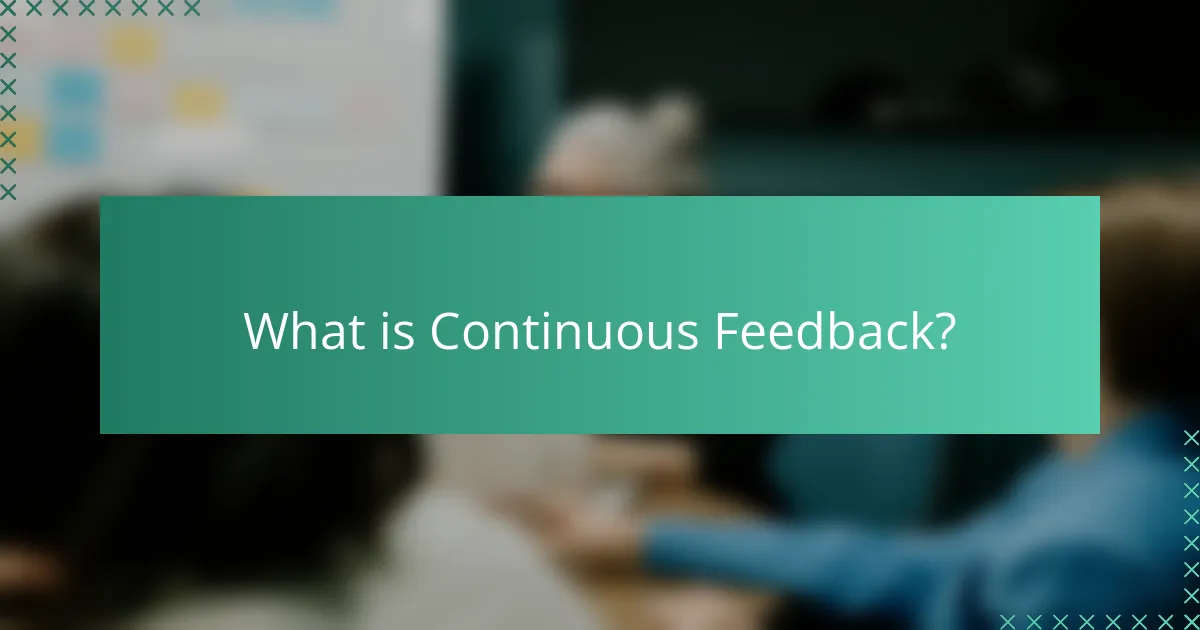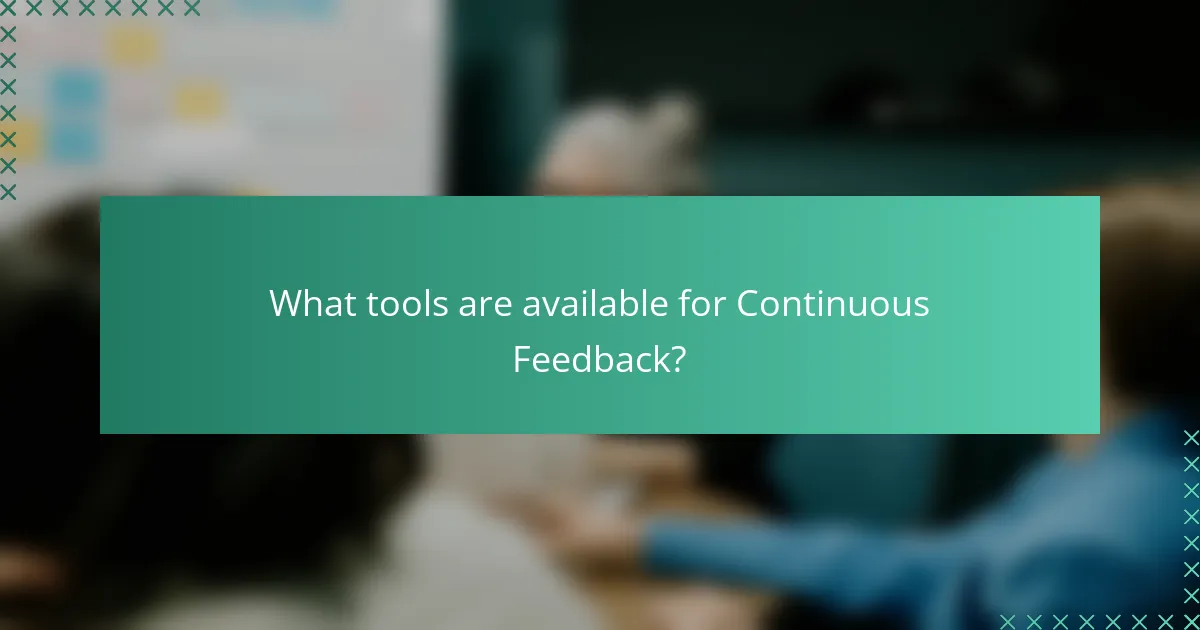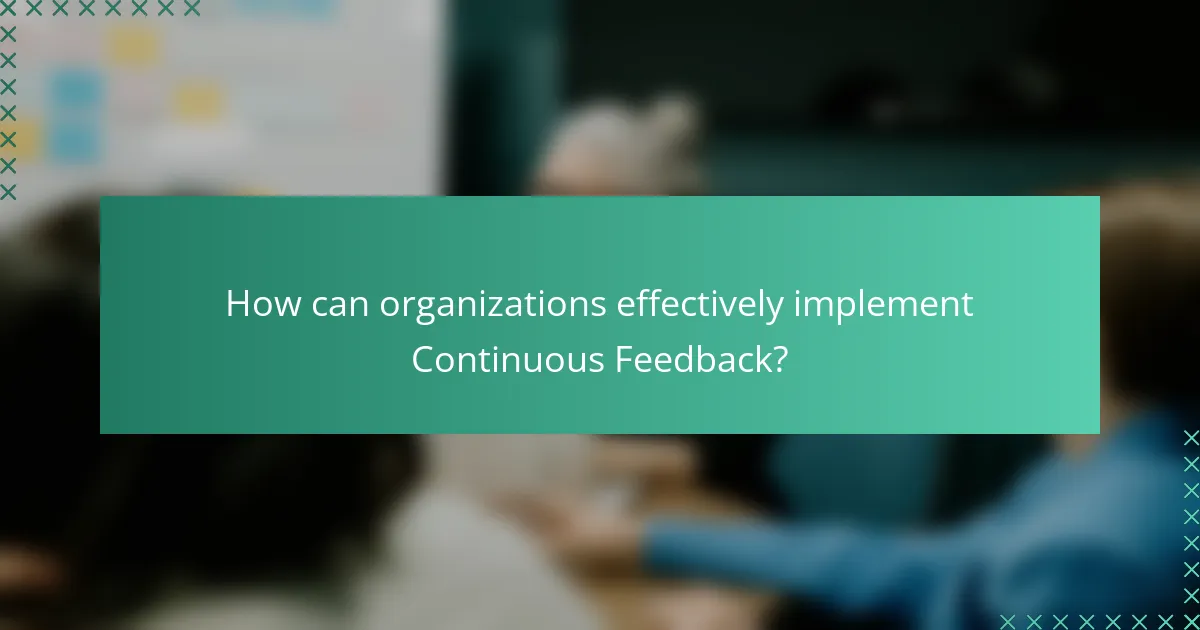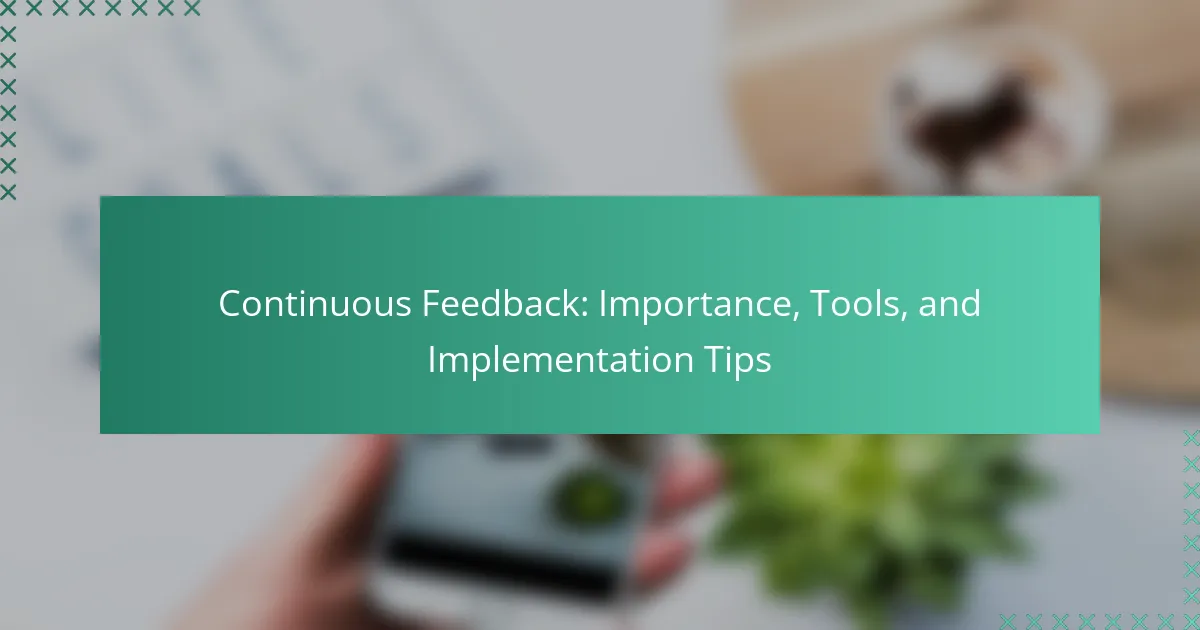Continuous feedback is a proactive approach to performance management that involves providing real-time input on employee behavior and performance. This method enhances learning and development by offering immediate insights, contrasting with traditional performance reviews that occur infrequently. Organizations utilizing continuous feedback, supported by tools like 15Five, TINYpulse, and Culture Amp, report increased employee engagement and satisfaction. Effective implementation requires establishing a culture of open communication, training employees and managers, and setting clear expectations for feedback frequency and format. Research indicates that strong feedback cultures can lead to significant improvements in employee engagement.

What is Continuous Feedback?
Continuous feedback is an ongoing process of providing real-time input on performance or behavior. This approach allows individuals to receive immediate insights, which can enhance learning and development. Continuous feedback contrasts with traditional performance reviews, which occur infrequently. Research shows that organizations using continuous feedback report higher employee engagement and satisfaction. The feedback can be delivered through various tools, including software platforms and regular check-ins. Such practices promote a culture of open communication and continuous improvement.
How does Continuous Feedback differ from traditional feedback methods?
Continuous feedback is an ongoing process that provides real-time insights, while traditional feedback methods are typically periodic and retrospective. Continuous feedback allows for immediate adjustments and improvements, fostering a culture of agility and responsiveness. In contrast, traditional feedback often occurs in annual reviews or set intervals, which may delay necessary changes. Research indicates that organizations utilizing continuous feedback see a 14.9% increase in employee engagement compared to those using traditional methods. This approach emphasizes frequent communication and collaboration, enhancing performance and development. Traditional methods can lead to outdated evaluations, whereas continuous feedback keeps performance relevant and aligned with current goals.
What are the key characteristics that define Continuous Feedback?
Continuous feedback is characterized by ongoing communication and assessment between team members. It promotes real-time insights into performance and behavior. This approach allows for immediate adjustments and improvements. Continuous feedback is typically informal and occurs frequently, rather than being limited to formal reviews. It encourages a culture of openness and trust within teams. Additionally, it focuses on specific behaviors and outcomes, rather than general evaluations. Research indicates that organizations utilizing continuous feedback see increased employee engagement and performance. This method aligns with agile methodologies, supporting adaptability in fast-paced environments.
Why is Continuous Feedback essential in modern workplaces?
Continuous feedback is essential in modern workplaces because it fosters a culture of open communication. This practice allows employees to receive timely insights on their performance. It helps in identifying areas for improvement quickly. Research shows that organizations with continuous feedback systems see a 14.9% increase in employee engagement. Furthermore, regular feedback helps align individual goals with organizational objectives. It promotes adaptability in a fast-paced work environment. Continuous feedback also enhances employee development and skill acquisition. This leads to higher productivity and job satisfaction.
What are the benefits of implementing Continuous Feedback?
Implementing Continuous Feedback enhances employee performance and engagement. It fosters a culture of open communication. Regular feedback helps identify areas for improvement in real-time. This approach increases accountability among team members. Studies show that organizations with continuous feedback have higher employee satisfaction rates. For example, a Gallup report indicates that feedback can improve performance by up to 14%. Continuous feedback also supports professional development by guiding employees on their growth paths. Ultimately, it leads to better team collaboration and a more agile work environment.
How does Continuous Feedback enhance employee engagement?
Continuous feedback enhances employee engagement by fostering open communication and ongoing development. It allows employees to receive real-time insights on their performance. This timely information helps them understand expectations and makes them feel valued. Regular feedback creates a culture of trust and collaboration. Employees are more likely to feel connected to their work and the organization. According to a Gallup study, organizations with high employee engagement have 21% higher profitability. Continuous feedback contributes to this by aligning individual goals with company objectives. It empowers employees to take ownership of their growth and development.
What impact does Continuous Feedback have on team performance?
Continuous feedback significantly enhances team performance. It fosters a culture of open communication and continuous improvement. Teams that receive regular feedback can identify strengths and weaknesses more effectively. This leads to quicker adjustments and better alignment with goals. Research shows that organizations with continuous feedback mechanisms report 14.9% higher employee engagement. Increased engagement often correlates with improved productivity and job satisfaction. Furthermore, continuous feedback allows for real-time recognition of achievements, boosting morale. Overall, the impact of continuous feedback is a more agile, engaged, and high-performing team.

What tools are available for Continuous Feedback?
Tools available for Continuous Feedback include software platforms like 15Five, TINYpulse, and Culture Amp. These tools facilitate ongoing communication between employees and managers. They allow for real-time feedback on performance and engagement. 15Five offers weekly check-ins to promote dialogue. TINYpulse provides anonymous feedback options to encourage honesty. Culture Amp focuses on employee engagement surveys. Each tool supports a culture of continuous improvement. They have been adopted by organizations to enhance workplace dynamics.
Which software solutions are best suited for Continuous Feedback?
Software solutions best suited for Continuous Feedback include platforms like 15Five, Lattice, and Culture Amp. 15Five allows regular check-ins and feedback loops, enhancing employee engagement. Lattice integrates performance management with continuous feedback features, promoting ongoing dialogue. Culture Amp specializes in employee engagement surveys and feedback tools, facilitating real-time insights. These tools support a culture of feedback, improving communication and performance. Their effectiveness is backed by user testimonials and case studies demonstrating increased employee satisfaction and productivity.
What features should organizations look for in Continuous Feedback tools?
Organizations should look for user-friendly interfaces in Continuous Feedback tools. A simple design enhances user engagement and adoption. Real-time feedback capabilities are essential. This feature allows immediate responses to employee performance. Customization options enable organizations to tailor feedback processes to their needs. Integration with existing HR systems streamlines data management. Analytics and reporting features provide insights into employee performance trends. Mobile accessibility ensures feedback can be given and received anywhere. Security measures protect sensitive employee data. These features collectively enhance the effectiveness of Continuous Feedback tools.
How do different tools compare in terms of usability and effectiveness?
Different tools vary significantly in usability and effectiveness. Usability refers to how easy a tool is to use. Effectiveness measures how well a tool achieves its intended purpose. For example, tool A may have a user-friendly interface, making it easy for users to navigate. In contrast, tool B might have a steeper learning curve but offers more advanced features.
Research shows that tools with higher usability often lead to increased user satisfaction. A study by Nielsen Norman Group indicates that 85% of users prefer tools that are easy to use over those that are feature-rich but complex.
Effectiveness can also be influenced by the specific needs of the organization. For instance, tool C may excel in providing actionable feedback but may lack integration with other systems. Tool D might be less effective in feedback delivery but integrates seamlessly with existing workflows.
Ultimately, the choice of tools should consider both usability and effectiveness based on the specific context and user requirements.
What are some innovative methods for gathering Continuous Feedback?
Innovative methods for gathering continuous feedback include real-time surveys, feedback kiosks, and mobile apps. Real-time surveys allow immediate responses after events or interactions. Feedback kiosks placed in strategic locations encourage spontaneous input. Mobile apps facilitate ongoing dialogue between users and organizations. Social media platforms can also be utilized for informal feedback collection. AI-driven chatbots can engage users and gather insights continuously. Video feedback tools enable users to express their thoughts visually. These methods enhance engagement and provide valuable data for improvement.
How can organizations leverage technology for real-time feedback?
Organizations can leverage technology for real-time feedback by utilizing digital tools and platforms. These technologies include instant messaging apps, survey tools, and feedback management systems. Instant messaging apps facilitate immediate communication between team members. Survey tools allow organizations to gather employee insights quickly and efficiently. Feedback management systems streamline the collection and analysis of feedback data.
Research shows that companies using real-time feedback tools see a 14% increase in employee engagement. This increase is linked to the ability to address issues promptly. Additionally, organizations can use analytics to track feedback trends over time. This data-driven approach enables informed decision-making.
By implementing these technologies, organizations foster a culture of open communication. This approach leads to continuous improvement and higher employee satisfaction.
What role does mobile accessibility play in Continuous Feedback?
Mobile accessibility enhances Continuous Feedback by enabling real-time communication. It allows users to provide and receive feedback instantly from anywhere. This immediacy increases engagement and responsiveness. Research indicates that 70% of employees prefer mobile tools for feedback. Mobile accessibility also ensures that feedback can be integrated into daily workflows. This integration leads to more frequent and meaningful interactions. Furthermore, it accommodates diverse work environments, including remote and on-the-go scenarios. Overall, mobile accessibility is crucial for fostering a culture of continuous improvement through timely feedback.

How can organizations effectively implement Continuous Feedback?
Organizations can effectively implement Continuous Feedback by establishing a culture of open communication. This involves training employees and managers on providing and receiving feedback regularly. Tools such as performance management software can facilitate ongoing feedback exchanges. Setting clear expectations about feedback frequency and format is essential. Regular check-ins and one-on-one meetings can help reinforce this practice. Encouraging peer feedback can also enhance the feedback loop. Research shows that organizations with strong feedback cultures see a 14.9% increase in employee engagement (Gallup). Thus, implementing these strategies fosters a supportive environment for Continuous Feedback.
What steps should be taken to introduce Continuous Feedback in a workplace?
To introduce Continuous Feedback in a workplace, start by creating a culture of open communication. This involves encouraging employees to share their thoughts and suggestions freely. Next, provide training on giving and receiving feedback effectively. This training should include specific techniques and examples. Implement regular check-ins between managers and employees to discuss performance and areas for improvement. Utilize technology tools that facilitate ongoing feedback, such as performance management software. Establish clear expectations regarding feedback frequency and format. Encourage peer-to-peer feedback to foster a collaborative environment. Finally, regularly assess the effectiveness of the feedback system and make necessary adjustments based on employee input.
How can leadership foster a culture of Continuous Feedback?
Leadership can foster a culture of Continuous Feedback by prioritizing open communication. Leaders should encourage team members to share their thoughts regularly. This creates a safe environment for feedback exchange. Training programs on giving and receiving feedback can be implemented. Regular check-ins and one-on-one meetings can facilitate ongoing dialogue. Utilizing technology tools for feedback collection can streamline the process. Research shows that organizations with continuous feedback have higher employee engagement. According to Gallup, teams that receive feedback regularly have 14.9% higher productivity.
What training is necessary for employees to adapt to Continuous Feedback?
Employees need training in communication skills to adapt to Continuous Feedback. This training should include active listening techniques. Employees should learn how to give and receive feedback constructively. Role-playing exercises can help them practice these skills in real scenarios. Training should also cover emotional intelligence to manage responses effectively. Understanding the purpose of Continuous Feedback is essential. Employees should be educated on how it contributes to personal and organizational growth. Workshops can provide hands-on experience with feedback tools and platforms. Regular follow-up sessions can reinforce these skills over time.
What common challenges arise during the implementation of Continuous Feedback?
Common challenges during the implementation of Continuous Feedback include resistance to change, lack of training, and unclear objectives. Employees may resist new feedback processes due to comfort with existing methods. Insufficient training can lead to misunderstandings about how to give and receive feedback effectively. Unclear objectives can result in inconsistent feedback, diminishing its value. Additionally, time constraints may hinder regular feedback sessions. A study by Gallup found that only 26% of employees feel they receive meaningful feedback, highlighting the prevalence of these challenges.
How can organizations address resistance to Continuous Feedback?
Organizations can address resistance to Continuous Feedback by fostering a culture of open communication. This involves training leaders to model feedback behaviors. Providing employees with clear guidelines on how to give and receive feedback is essential. Regular workshops can help demystify the feedback process. Organizations should also emphasize the benefits of Continuous Feedback, such as improved performance and engagement. Sharing success stories can illustrate its positive impact. Additionally, organizations can implement feedback tools that simplify the process. These tools should be user-friendly and accessible to all employees.
What strategies can be employed to ensure consistent participation?
To ensure consistent participation, implement regular communication and engagement strategies. Regular check-ins can help maintain interest and commitment. Creating a structured schedule for participation encourages accountability. Utilizing incentives, such as recognition or rewards, can motivate ongoing involvement. Providing clear expectations and goals fosters a sense of purpose among participants. Utilizing feedback tools can enhance engagement by allowing participants to share their thoughts. Research shows that consistent communication increases participation rates significantly. A study by the Harvard Business Review found that teams with regular feedback loops see a 25% increase in engagement.
What best practices should organizations follow for successful Continuous Feedback?
Organizations should prioritize open communication for successful Continuous Feedback. Clear dialogue fosters trust and encourages employees to share their thoughts. Regular check-ins should be scheduled to maintain ongoing conversations. These discussions should focus on specific performance areas, allowing for targeted feedback. Utilizing technology can streamline feedback processes and make them more accessible. Training managers in effective feedback techniques enhances their ability to provide constructive insights. Encouraging a culture of feedback helps normalize the practice among all employees. Finally, organizations should act on feedback received to demonstrate its value and impact.
How can organizations measure the effectiveness of Continuous Feedback initiatives?
Organizations can measure the effectiveness of Continuous Feedback initiatives through various metrics. Key performance indicators (KPIs) such as employee engagement scores can indicate the impact of feedback on morale. Additionally, tracking the frequency of feedback interactions can provide insights into participation levels. Surveys can assess perceived value and relevance of feedback received. Retention rates may reflect the overall effectiveness of feedback in employee satisfaction. Performance improvement metrics can demonstrate changes in productivity linked to feedback initiatives. Finally, analyzing feedback implementation rates can show how well employees act on the feedback provided. These methods collectively validate the effectiveness of Continuous Feedback initiatives.
What tips can help maintain the quality of feedback over time?
Regularly solicit feedback from diverse sources. This ensures varied perspectives. Use structured formats for feedback collection. Structured formats enhance clarity and reduce ambiguity. Schedule periodic reviews of feedback practices. Regular reviews help identify areas for improvement. Provide training for feedback givers. Training ensures consistency in feedback quality. Foster a culture of openness and trust. A trusting environment encourages honest feedback. Utilize technology tools that track feedback trends. Technology can streamline analysis and highlight patterns.
Continuous feedback is an ongoing process that provides real-time input on employee performance and behavior, contrasting sharply with traditional feedback methods that are periodic and retrospective. The article explores the importance of continuous feedback in modern workplaces, highlighting its benefits such as increased employee engagement and satisfaction, as well as its impact on team performance. It discusses various tools and software solutions available for implementing continuous feedback, along with best practices, innovative methods for gathering feedback, and strategies to overcome common challenges during implementation. The emphasis is on fostering a culture of open communication and continuous improvement to enhance overall organizational effectiveness.
